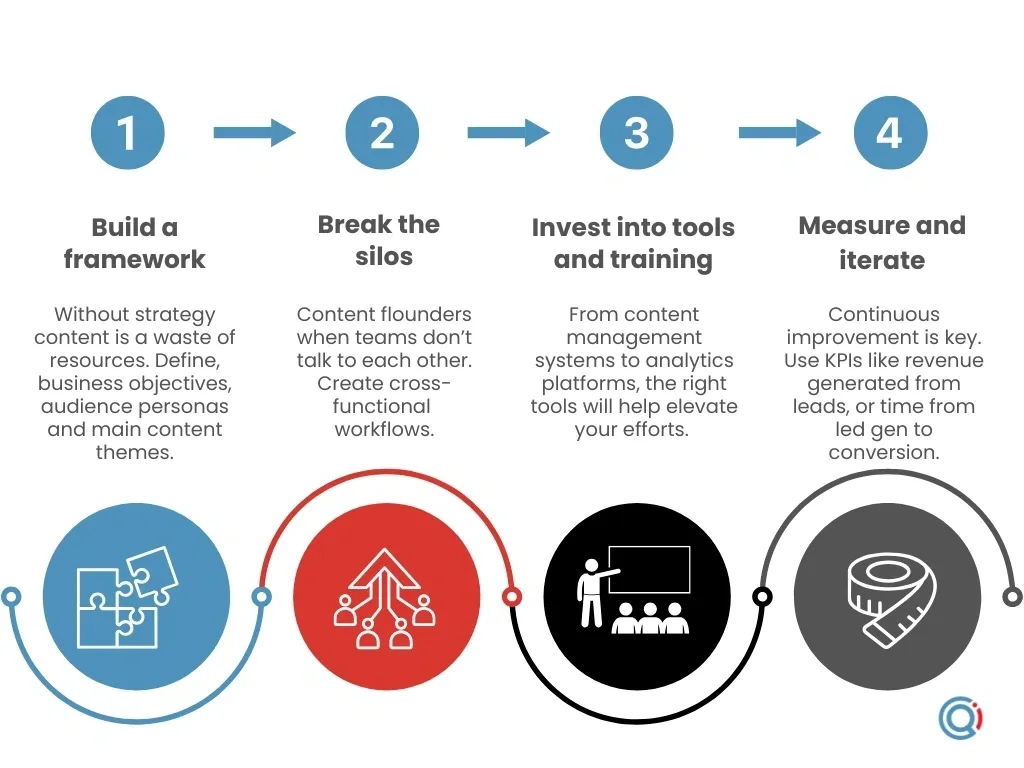Every B2B and science-led company strives to communicate its expertise effectively. But what if your content efforts aren’t quite delivering? If you’ve been putting out whitepapers, webinars, and blog posts but still aren’t seeing meaningful engagement, it is time to assess your content maturity. This guide will show you how to pinpoint where your organisation stands and develop a roadmap for growth.
“Content chaos” or “Content catalyst”?
Before you can make a plan of how you will level up, you need to know your starting point. Content maturity levels can range from “barely started” to “fully optimised and strategically aligned.” Here are the four most common stages that we see from the companies that we work with:
- Ad hoc: Your marketing team is purely reactive, producing content when someone like product or sales requests it—often at the last minute. Strategy? What strategy- you’re just trying to keep the lights on.
- Emerging: Your team has a content plan, a calendar and a few processes in place, but it is still a struggle to connect content to larger business goals. Perhaps it’s a case of a missing communication line directly with the C-suite, or perhaps marketing is siloed from the sales and broader business performance discussions.
- Operationalized: Content marketing is a well-oiled machine, with processes in place, but silos are still holding you back from full integration.
- Strategic: Content production is based on data, which is a combination of external signals, performance of past content and information received from other groups internally. This ensures your content is aligned with the buyer profiles and their journeys and serves as a core business asset.

The problem is that without diagnosing where you are, you won’t have clarity of the stage that your team is at, making it very difficult to come up with an impactful plan that will help move your whole marketing output to another inflexion point. You need to know, are you lagging behind the competitors? Or overspending on ineffective tactics? Or both?
These are uncomfortable questions to ask but imagine this scenario: your sales team needs a case study to close a deal. Instead of having one ready, they scramble to pull together slides from past presentations, ending up with something inconsistent and underwhelming. Your competitor, meanwhile, wows the same prospect with a polished, on-brand piece.
The domino effect of disorganised content
When content maturity is low, the cracks show up everywhere. Here’s what happens when you don’t address it:
- Wasted resources: Product, sales, tech support, marketing and events teams spend hours reinventing the wheel for every campaign.
- Missed opportunities: High-value prospects slip through the cracks because your content doesn’t speak to their specific needs.
- Brand erosion: Disjointed or low-quality content weakens your reputation, especially for science-led companies where credibility is an absolute non-negotiable.
- Messaging confusion: Various teams who interact with your prospective customers, message differently, creating confusion and inconsistencies over offers and benefits amongst your audience.
Imagine a scenario of launching a groundbreaking product only to realise you don’t have a cohesive set of content assets—no landing pages, no tailored email campaigns, no industry-specific case studies, no clear CTAs on the offer, no follow-up or nurture plan in place for the warm prospects. The result? Poor adoption rates and a frustrated sales team.
Auditing like a scientist is not that hard
To fix the problem, you need data, and conducting a thorough content audit is your first step. For a full breakdown of how to run a content audit, read this article or commission Qincade to do it for you. Briefly, though, this is what’s involved:
- Inventory your assets: List everything-whitepapers, blogs, videos, sales decks, you name it.
- Check for alignment: Is your content mapped to the stages of the buyer journey? Does it reflect your brand’s voice and expertise?
- Evaluate performance: Use analytics to identify what’s working and what’s gathering digital dust.

For science-led companies, ensure your content is not just technically accurate but also accessible to a range of audiences – from technical buyers and sales folk to executive decision-makers. This is a critical point to remember when you are thinking about creating content since the decision-making process within Life Sciences companies typically involves between 6-10 individuals [1], each with distinct concerns and areas of focus. Furthermore, your products will often be sold by others – for example, professionals working within OEMs. It should be made easy for them to educate themselves about your products so that they can talk about them with ease to their prospects.
Developing your content maturity roadmap
Once you know where you stand, it’s time to plot a course. Here is a four-step process that will help you achieve improved results.
1. Build a strategic framework
Content without strategy is like a ship without a rudder, so you will need to be able to define business objectives, audience personas and main content themes. Think about whether you are after lead generation metrics, whether it’s thought leadership that extends to brand-building and education/awareness goals, or whether customer retention is your biggest priority. We all say this over and over again, but it is true – without understanding the challenges your prospective buyers face in their day-to-day, it is really hard to craft messages and create content that they will spend any of their time reading. More than that, pitch the wrong way to your prospects, and you risk losing their attention forever. Ensure that your content and CTAs align with your company’s expertise and positioning – always. For example, if you are a biotech company marketer targeting primarily pharmaceutical clients, you’ll likely focus on themes like regulatory trends, R&D innovation and challenges, as well as cost and time-saving strategies to help them win.
2. Work on eliminating the silos
Content often flounders when the teams who are responsible for communicating with the customers don’t talk to each other. Create cross-functional workflows involving marketing, sales, and subject matter experts. One of the ways to assist with this is to set up a centralized content hub with ready-to-go assets tailored for common customer objections. Host regular meetings or workshops to talk about improving lead management processes and to share customer-centric insights.
3. Spend time and budget on tools and training
From content management systems to analytics platforms, the right tools will help elevate your efforts and support the running of your content marketing delivery machine. It might be tempting to skip training – but your teams need to have full understanding of the tools that simplify their jobs and the strategic intent and prowess behind them. Training the sales team on how marketing operates is also key to addressing point 2 as above and can ensure that product marketing understands how you operate and vice versa. Reviewing successful sales scripts from your top salespeople and sharing those with your content marketers is essential. Consider making it easy for all individuals in your company who work with customers to suggest content topics around industry trends and hot topics, ensuring that data is also available on previously produced content for comparison.
4. Measure and iterate
In the post-implementation phase, continuous improvement is the name of the game. Use KPIs from the list below to evaluate success:
- Revenue generated from content: Track revenue generated from leads that interacted with specific content pieces. Use CRM integrations to attribute deals to the right content assets.
- Sales enablement impact: Monitor how often sales teams use content in pitches and the conversion rates of those leads. Tools like sales enablement platforms can provide usage and effectiveness data.
- Buyer journey acceleration: Look at whether or not the time prospects spend in each stage of the funnel is reducing.
- Audience retention metrics: Repeat visits and sustained engagement over time indicate your content is relevant and engaging.
- Cost-per-qualified lead (CPQL): What is the cost efficiency of content in attracting qualified leads? Divide content production and distribution costs by the number of leads that meet your qualification criteria. Be wary of doing this though, if you are not confident of the purity of the data feeding this equation. It is better to avoid calculating this altogether if you suspect your data isn’t accurate enough.
- Engagement-to-action ratio: Conversion of engagement into tangible actions like increased activation on your key CTAs.
- Share of voice in niche topics: Thought leadership measured by mentions and rankings
- Content lifecycle ROI: Look at tracking over the long-term the performance of your content against its overall cost, although bear in mind that the total cost of producing content and distributing it is far higher than simply looking at how much your content writers charged for a blog post or how much an agency was paid to create a certain eBook etc.
For a quick win, consider running A/B tests on key content formats (e.g., short explainer videos vs. long-form articles) to refine what resonates the most with your audience.

Science meets storytelling -> meets scientific approach
For B2B and science-led companies, content isn’t just about filling up a blog and doing some posts on LinkedIn about which conference your team is attending next; it is a critical tool for building trust, educating your audience, and driving business results. By assessing your content maturity and committing to a plan for growth, you can turn your content strategy into a competitive advantage. Just imagine a scenario where a prospect downloads your whitepaper, triggering a personalized email series that guides them through their buyer journey. When they’re ready to talk, your sales team steps in with targeted insights, supported by case studies and testimonials tailored to the prospect’s industry. That’s the power of a strategic and mature content operation.
If you are ready to transform your content approach, start with an honest audit and a vision for where you want to go. Your future customers, and your bottom line will thank you.
Need help with running a content audit to get you started?
We can help, DM us via LinkedIn or email us at: hello@qincade.com and tell us more about how we can support your strategic ambitions.
References





